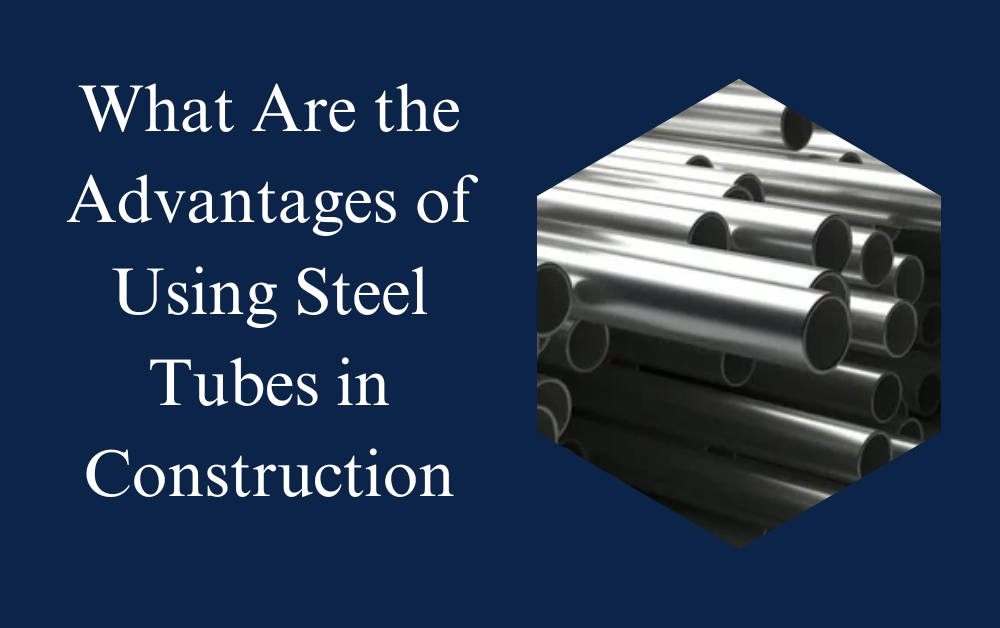Steel tubes have become an essential part of construction projects around the world. Whether it’s building large structures like bridges, skyscrapers, or smaller residential buildings, steel tubes are widely used due to their strength, durability, and versatility. In this blog, we will explore the various advantages of using steel tubes in construction, breaking down the benefits in simple and easy-to-understand terms.
Note : If you’re ready to take your construction project to the next level, steel tubes offer the strength, durability, and flexibility you need. Contact us today to learn how steel tubes can enhance your build and ensure long-lasting results. Let’s get started on building something great together
What Are Steel Tubes?

Before we dive into the advantages, let’s first understand what steel tubes are. Steel tubes are long, hollow cylinders made from steel. They come in different shapes, such as round, square, and rectangular, and are used for various purposes in construction, engineering, and manufacturing. Steel tubes are often confused with steel pipes, but they have different applications. While steel pipes are usually used to transport fluids and gases, steel tubes are mainly used for structural purposes.
Now that we have a basic idea of what steel tubes are, let’s look at their advantages in construction.
Strength and Durability
Why Are Steel Tubes So Strong?
One of the main reasons why steel tubes are used in construction is because of their incredible strength. Steel itself is a strong material, and when it’s shaped into a tube, it becomes even stronger. The tubular shape helps distribute weight evenly, which allows the tubes to bear heavy loads without bending or breaking easily.
How Does Durability Play a Role?
In addition to being strong, steel tubes are highly durable. They can withstand harsh weather conditions, such as extreme heat, cold, or heavy rain, without deteriorating over time. This makes steel tubes a great choice for construction projects that need to last for many years. The durability of steel tubes also means that maintenance costs are lower compared to other materials that may require frequent repairs or replacements.
Flexibility and Versatility
What Makes Steel Tubes Flexible?
Another significant advantage of using steel tubes in construction is their flexibility. Steel tubes can be molded and shaped to fit various designs, which makes them a great option for both simple and complex construction projects. Whether you’re building a straight beam for a bridge or a curved railing for a staircase, steel tubes can be easily customized to suit the needs of your project.
Versatility in Different Projects
Steel tubes are versatile and can be used in many different types of construction projects. They can be used as structural supports in buildings, frames for roofs, handrails, fences, and more. Because they come in different shapes and sizes, steel tubes can adapt to almost any project, making them a valuable asset in construction.
Cost-Effectiveness
Are Steel Tubes Affordable?
When it comes to construction, cost is always an important factor to consider. Steel tubes may not always be the cheapest material available, but they offer great value for the price. Their strength and durability mean that they can last for many years without needing repairs or replacements, which can save money in the long run.
Lower Maintenance Costs
Because steel tubes are resistant to damage and wear, they require less maintenance compared to other materials like wood or plastic. This reduces the overall cost of maintaining a structure over time. Additionally, steel tubes are easy to clean and do not easily corrode, which adds to their long-term cost-effectiveness.
Environmentally Friendly
Can Steel Tubes Be Recycled?
One of the lesser-known advantages of using steel tubes in construction is that they are environmentally friendly. Steel is one of the most recyclable materials in the world. After a building or structure has reached the end of its life, the steel tubes can be melted down and reused to create new steel products. This reduces the need for raw materials and minimizes waste, making steel tubes a sustainable choice for construction.
Reducing Environmental Impact
By using recyclable materials like steel tubes, construction projects can lower their environmental impact. Recycled steel tubes can be used in new buildings, reducing the demand for mining new resources. This contributes to a more sustainable construction industry and helps reduce the carbon footprint associated with building projects.
Resistance to Fire, Pests, and Weather
How Do Steel Tubes Handle Fire?
Safety is a top priority in any construction project, and steel tubes offer excellent fire resistance. Unlike wood, which can easily catch fire, steel is non-combustible. This means that steel tubes can help prevent the spread of fire in the event of an accident. Many builders choose steel tubes for structures that need to meet strict fire safety regulations, as they provide added protection.
Protection Against Pests
Steel tubes are also resistant to pests such as termites and rodents. In contrast, materials like wood can be damaged by pests, leading to structural problems. Steel tubes do not provide a food source for pests, which makes them a more reliable option for long-term construction projects, especially in areas where pest infestations are common.
Withstanding Harsh Weather Conditions
Steel tubes are known for their ability to withstand harsh weather conditions. Whether it’s heavy rain, strong winds, or snow, steel tubes remain sturdy and unaffected. This is particularly important for structures that are exposed to the elements, such as bridges, towers, and outdoor stadiums. The weather-resistant nature of steel tubes ensures that the structure stays safe and intact, even in extreme conditions.
Lightweight Yet Strong
Are Steel Tubes Heavy?
One might think that because steel is a strong material, it must also be heavy. However, steel tubes are surprisingly lightweight compared to their strength. The hollow design of the tube reduces the overall weight while still maintaining its ability to carry heavy loads. This makes steel tubes easier to transport and install on construction sites.
Benefits of Lightweight Construction Materials
Using lightweight materials like steel tubes can make construction projects more efficient. Since steel tubes are easier to handle, they can be installed faster, reducing the time and labor required for construction. This can lead to cost savings and quicker project completion, making steel tubes a practical choice for builders.
Easy Installation and Assembly
How Are Steel Tubes Installed?
Another advantage of steel tubes is that they are relatively easy to install and assemble. Steel tubes can be cut, welded, and joined together using simple tools, making them convenient to work with on construction sites. The straightforward installation process also reduces the risk of errors during assembly, which can improve the overall quality of the project.
Prefabrication of Steel Tubes
In some cases, steel tubes can be prefabricated off-site and delivered to the construction location. This means that the steel tubes are already shaped and cut to the required dimensions before they arrive on-site. Prefabrication saves time and reduces waste during the construction process, making it an efficient option for builders.
Aesthetic Appeal
Do Steel Tubes Look Good?
Beyond their practical benefits, steel tubes also offer aesthetic advantages. Many modern buildings and structures use steel tubes as part of their design to achieve a sleek, industrial look. The clean lines and smooth surfaces of steel tubes can enhance the appearance of a building, giving it a contemporary and stylish look.
Customization for Design Flexibility
Steel tubes can be customized to suit the design preferences of architects and builders. They can be painted, coated, or galvanized to match the desired aesthetic of a project. This flexibility in design makes steel tubes a popular choice for architects who want to create visually appealing structures without compromising on strength and durability.
Conclusion
In summary, steel tubes offer a wide range of advantages that make them a preferred choice in the construction industry. Their strength, durability, and versatility allow them to be used in a variety of projects, from small residential buildings to large industrial structures. Steel tubes are cost-effective, environmentally friendly, and resistant to fire, pests, and harsh weather conditions, making them a reliable option for long-lasting construction.
The lightweight nature of steel tubes, combined with their easy installation and aesthetic appeal, adds to their value. Whether you’re building a simple structure or a complex architectural masterpiece, steel tubes provide the strength and flexibility needed to bring your project to life.
If you’re considering using steel tubes in your next construction project, now you know why they are such a popular and practical choice. The many advantages they offer make them a solid investment for any builder or architect looking to create safe, durable, and visually appealing structures.
For more insightful articles related to this topic, feel free to visit : viewsparrow.com















Leave a Reply